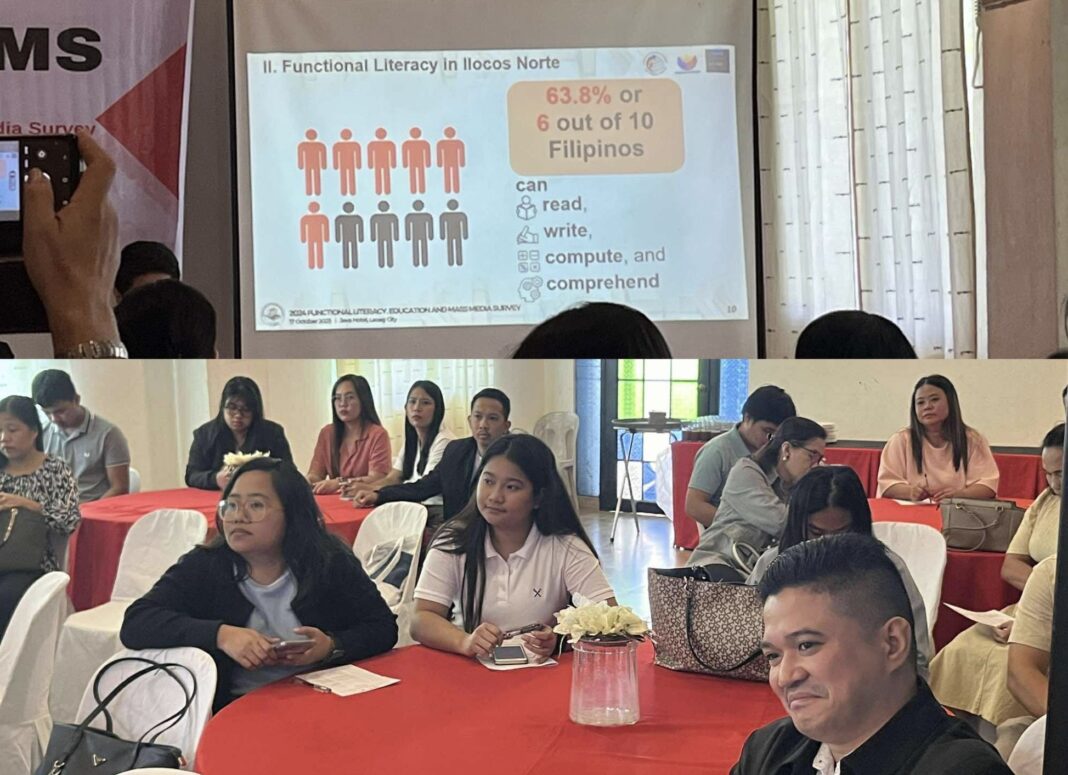By Mary Therese D. Ancheta
LAOAG CITY, Ilocos Norte — The Philippine Statistics Authority (PSA) reported that Ilocos Norte recorded the second highest basic literacy rate in Region 1 at 89.7%, based on the 2024 Functional Literacy, Education, and Mass Media Survey (FLEMMS).
The findings were presented by Mary Joy P. Mapugay, statistical analyst of PSA Ilocos Norte, during a data dissemination forum held on October 17, 2025, at the Java Hotel in Laoag City.
Mapugay noted that nine out of 10 Ilocanos aged five and above can read, write, and perform basic math operations with understanding.
“Basic literacy refers to the ability to read and write a simple message in any language or dialect with understanding and to perform basic math operations,” Mapugay explained.
Among the four provinces, Ilocos Sur ranked first with 93.4%, followed by Ilocos Norte (89.7%), La Union (89.2%), and Pangasinan (88.7%).
By sex, females aged five and above in Ilocos Norte showed higher literacy (91%) than males (88.3%).
The survey also revealed that younger age groups displayed stronger literacy skills, with the 20–24 age group posting the highest rate (96.3%), while the lowest was among those aged 60 and above (88.1%).
By educational attainment, individuals who reached or completed college recorded the highest literacy (96.6%), while those who did not complete early childhood education had the lowest (57.2%).
Functional literacy
While the province recorded high basic literacy, functional literacy—which measures reading comprehension and application skills—remains low.
“Functional literacy involves not only reading and writing but also understanding and applying information,” Mapugay said.
Based on the 2024 FLEMMS, six out of 10 Ilocanos aged 10–64 are functionally literate, or able to read, write, compute, and comprehend.
Among the four provinces in the region, La Union posted the highest functional literacy rate at 71.5%, followed by Ilocos Norte at 63.8% and Pangasinan at 62.3%.
As with basic literacy, females again outperformed males, with 70.4% functionally literate females compared to 57.5% of males.
By age group, those aged 15–19 years had the highest functional literacy rate (72.6%), while ages 50–59 had the lowest (51.1%).
College graduates or those with higher education achieved the highest functional literacy (84.4%), while individuals with incomplete or early childhood education scored only 15.2%.
Comprehension program needs
Mapugay pointed out a significant gap between basic and functional literacy, revealing that while 89.7% of Ilocanos aged 10–64 can read and write, only 63.8% can fully comprehend, a difference of 25.9 percentage points.
“This means that for every 100 individuals who can read and write, around 26 struggle with comprehension,” she said.
The largest gap was seen among those aged 50–59, where about 39 out of every 100 literate individuals have comprehension difficulty.
Mapugay emphasized the need for continuous learning and comprehension programs, especially for older adults and those with limited education.
Among key government literacy initiatives under the Department of Education (DepEd) include the following:
- Summer Reading Program, which strengthens literacy and numeracy skills among struggling learners during school breaks;
- Literacy Remediation Program (LRP), which helps students with reading difficulties through focused interventions;
- Bawat Bata Makababasa (BBM) Program, a nationwide initiative that ensures every learner can read at the appropriate grade level;
- Catch-Up Fridays/Reading Program, which holds weekly reading and comprehension activities to improve literacy; and
- ARAL (Academic Recovery and Accessible Learning) Program, which aids students in recovering learning losses caused by the pandemic.
The 2024 FLEMMS results, according to the PSA, aim to guide policymakers, educators, and LGUs in crafting evidence-based literacy programs that improve both access and quality of learning. (CCMT/MTDA, PIA Ilocos Norte)






